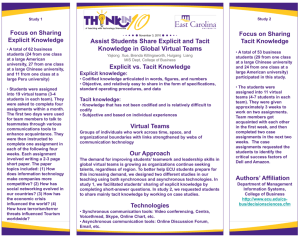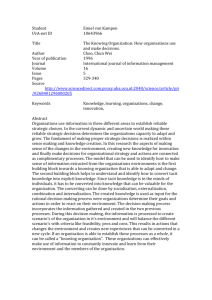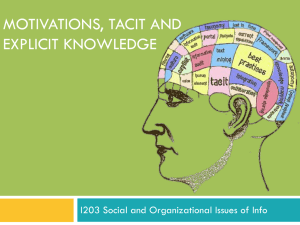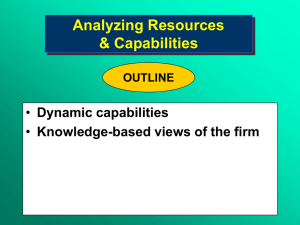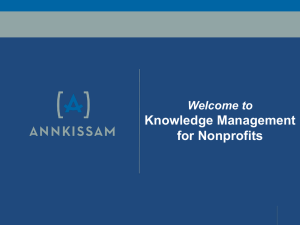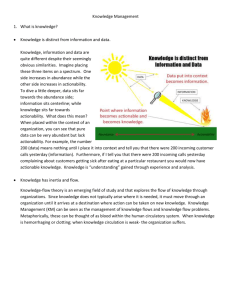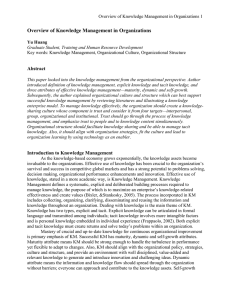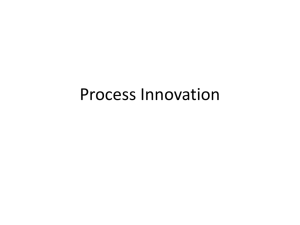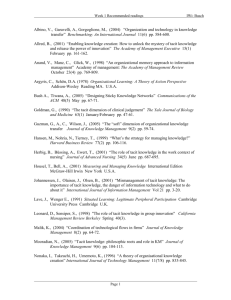Organizational Behavior 11e
advertisement
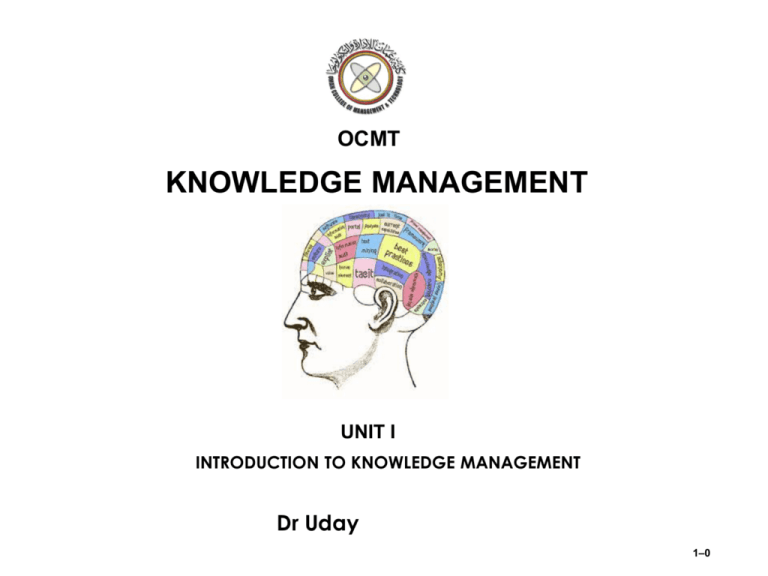
OCMT KNOWLEDGE MANAGEMENT UNIT I INTRODUCTION TO KNOWLEDGE MANAGEMENT Dr Uday 1–0 UNIT I - INTRODUCTION TO KNOWLEDGE MANAGEMENT Learning objectives 1. Meaning and definition 2. Basic terminology: Data, information and knowledge 3. Characteristics of knowledge 4. Types of knowledge: Explicit and tacit 5. Difference between explicit and tacit knowledge 6. Concept of knowledge management 7. Benefits of knowledge management 8. Forces driving knowledge management 9. Intellectual capital: Types 10. Knowledge management system cycle 1–1 1. Knowledge Management: Meaning and Definition Knowledge Management (KM) is a process of acquiring, creating and sharing knowledge in order to achieve the organizational objectives by making the best use of the knowledge. KM is a group of systems and practices for identifying, capturing, storing and disseminating information 1–2 2. Basic terminology: Data, Information and Knowledge Old Py – data • information – knowledge » wisdom Definition Reason DATA INFORMATION KNOWLEDGE Raw facts, figures and records contained in a system. Data placed into a form that is accessible, timely and accurate. Processing Storing / Accessing. Information in context to make it insightful and relevant for human action. Insight, innovation, improvement. Collection of facts, measurements, statistics Organized data, Contextual, relevant, actionable information 3 3. Characteristics of knowledge 1. 2. 3. 4. Explicitness careful thoroughness of detail ; leaving nothing merely implied Codifiability Arranged in systematic collection Teachability suitability for use in teaching Knowledge Specificity Specific knowledge possessed 1–4 4. Types of Knowledge: Explicit and Tacit 1. Explicit: Explicit knowledge is the knowledge that is codified, recorded, or actualized into some form outside of the head Eg.: Books, periodicals, journals, maps, photographs, audiorecordings, web pages, websites, portals 2. Tacit: Tacit knowledge is the knowledge that is available from experience and insight, not in a recorded form, but in our heads and intuition. 1–5 5. Explicit and Tacit: Differences Documented information that can facilitate action. Explicit knowledge Know-how & learning embedded within the minds people. Tacit (Implicit) knowledge 1. Formal or codified 1. Informal and un-codified 2. Documents: reports, policy manuals, white papers, standard procedures 2. Values, perspectives & culture 3. Databases 3. Knowledge in heads 4. Books, magazines, journals (library) 4. Memories of staff, suppliers and vendors 1–6 6. Concept of Knowledge Management 1. There are two general types of information, explicit and tacit. 2. Tacit and Explicit Knowledge often conflict. 3. Not all information is valuable. 4. Need to recognize how people communicate and share information and knowledge “I know that’s what the manual says, but this is how we really do it” The explosion of communication modalities means that you need a triage function. People know more than what they say, and they say more than what they write down. 1–7 7. Benefits of KM 1. 2. 3. 4. 5. Leveraging core business competencies Accelerating innovation and time to market Improving cycle times and decision making Strengthening organizational commitment Building sustainable competitive advantage 1–8 8. Forces driving KM 1. 2. 3. 4. Increasing Domain Complexity Accelerating Market Volatility Intensified Speed of Responsiveness Diminishing Individual Experience 1–9 Forces driving KM: Summary 1. Increasing Domain Complexity: Intricacy of internal and external processes, increased competition, and the rapid advancement of technology all contribute to increasing domain complexity. 2. Accelerating Market Volatility: The pace of change, or volatility, within each market domain has increased rapidly in the past decade. 3. Intensified Speed of Responsiveness: The time required to take action based upon subtle changes within and across domains is decreasing. 4. Diminishing Individual Experience: High employee turnover rates have resulted in individuals with decision-making authority having less tenure within their organizations than ever before. 1–10 Increasing Domain Complexity Complexity of the underlying knowledge domains is increasing. Thus, complexity of the knowledge required to complete a specific business process task has increased as well. Intricacy of internal and external processes, increased competition, and the rapid advancement of technology all contribute to increasing domain complexity. Example: New product development now typically requires: - not only brainstorming sessions by freethinking product designers - but also partnership of inter-organizational teams representing many various functional subunits (finance, marketing, engineering, …) Professional recruiters increasingly emphasize not just excellent educational and professional qualifications, but also have outstanding communication and team collaboration skills… enabling them to share their knowledge for the benefit of the organization. 1–11 Accelerating Market Volatility The pace of change, or volatility, within each market domain has increased rapidly in the past decade. Market and environmental influences can result in overnight changes in an organization. Corporate announcements of a missed financial quarterly target could send a company’s capitalization into a downward spiral. - Along with their entire industry, sometimes! Stock prices have become increasingly volatile in recent years - A result of “day trading” phenomenon (sharp increase in nonfinancial professionals who are making a living from exploiting steep market fluctuations). 1–12 Intensified Speed of Responsiveness The time required to take action based upon subtle changes within and across domains is decreasing. Rapid advances in technology is continually changing the decision-making landscape. - Decisions must be made and implemented quickly – otherwise the window of opportunity closes. Example: hotel booking business - Yesterday… low-tech… customer makes a request individual sales representatives return to the office discuss the opportunity with their manager draft a proposal mail the proposal to the client client accepts or rejects the offer - Today… with online auctioning/bidding markets… hotel manager: “should I book a $200 room for the bid offer of $80 and fill the room, or risk not accepting the bid hoping to get a walk-in customer that will pay the $200?” manager only has minutes after a bid offer to make the decision! 1–13 Diminishing Individual Experience High employee turnover rates have resulted in individuals with decision-making authority having less tenure within their organizations than ever before. • Example: Fortune 300 CEOs Proportion below age 50: -1998: 5% -2000: 15% Median tenure in office: -1998: 7 years -2000: 5 years 1–14 9. Intellectual Capital: Types 1. Human capital The body of knowledge the company possesses Knowledge in the minds of Microsoft and Yahoo’s software developers, researchers, academic collaborators, business managers, … Also, knowledge in the minds of vendors and customers 2. Structural capital Everything that remains after the employees go home Copyrights, customer files, business process software, databases, software manuals, trademarks, organizational structures, … In other words, organizational capability Intellectual capital is ubiquitous – but there are still no standard tools to manage it as an asset! 1–15 10. Knowledge Management System Cycle 1. 2. Creates knowledge through new ways of doing things Create Identifies and captures new knowledge Capture Knowledge 3. Places knowledge into context so it is usable 4. Stores knowledge in repository 5. Reviews for accuracy and relevance 6. Makes knowledge available at all times to anyone Refine Disseminate Manage 7. Store Disseminated knowledge becomes tacit to become explicit again in the cycle. 1–16

